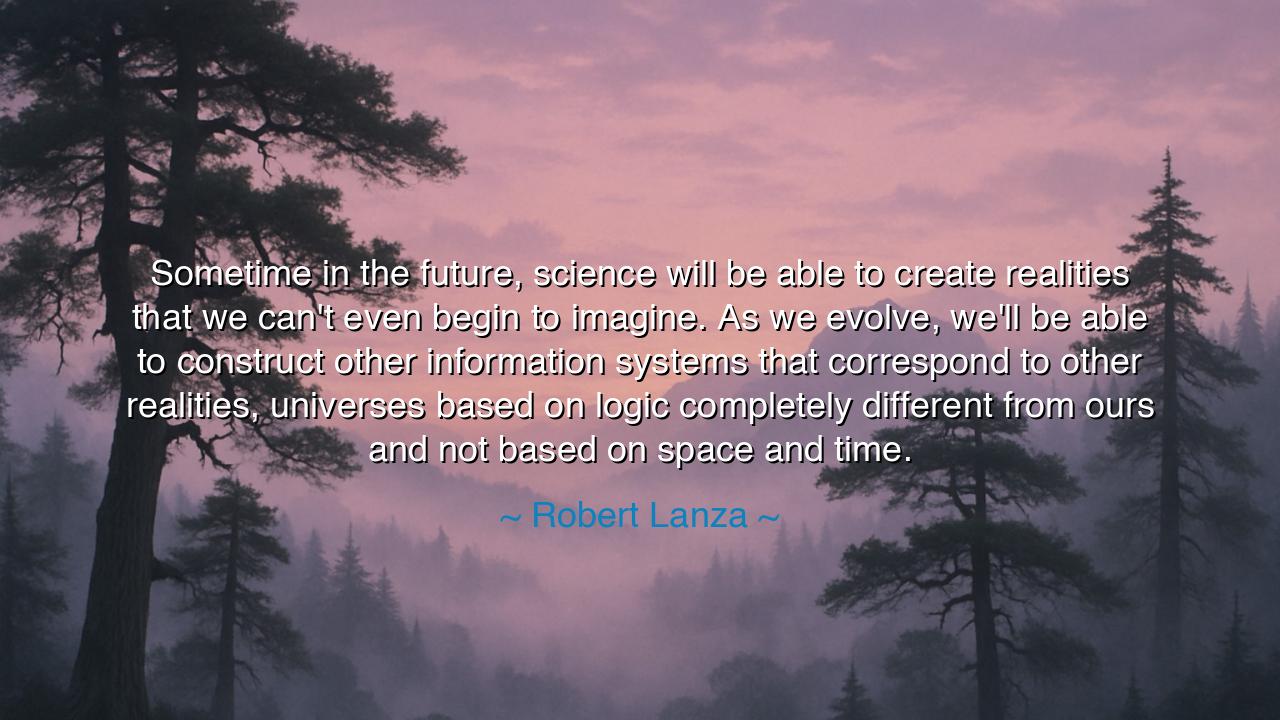
Sometime in the future, science will be able to create realities
Sometime in the future, science will be able to create realities that we can't even begin to imagine. As we evolve, we'll be able to construct other information systems that correspond to other realities, universes based on logic completely different from ours and not based on space and time.






"Sometime in the future, science will be able to create realities that we can't even begin to imagine. As we evolve, we'll be able to construct other information systems that correspond to other realities, universes based on logic completely different from ours and not based on space and **time." These words of Robert Lanza speak to a deep and profound truth—that the future holds possibilities beyond the scope of our current understanding, that as humanity evolves, so too will our capacity to understand and create realities beyond the constraints of space and time. This is not just a reflection on science or technology; it is a glimpse into the unlimited potential of the human spirit and mind to transcend the boundaries that currently define our world.
The ancients were no strangers to the idea that the boundaries of human existence were not fixed. Plato, in his writings, spoke of the World of Forms, a reality beyond the physical world, a realm of perfect ideas that existed outside of space and time. For Plato, this world was one of ideal forms that could not be touched by the imperfections of the physical world. What Robert Lanza speaks of is the possibility of creating such worlds—not through philosophical musings, but through the application of science and technology. In the future, we may be able to construct worlds not bound by the laws of nature as we know them but by new forms of logic, just as Plato imagined a realm beyond our current reality.
The idea of alternative realities is not new to humanity. The ancient myths of various cultures often spoke of worlds beyond our own—heavens, underworlds, and parallel dimensions—where gods, spirits, and immortal beings dwelled. The Norse spoke of the nine worlds connected by the great tree Yggdrasil, each governed by its own set of rules and logic. Indian philosophy speaks of the Maya, the illusion of our physical world, suggesting that the reality we perceive is but a shadow of a deeper, more fundamental truth. These ancient teachings, though couched in myth, sought to explain the infinite possibilities of existence beyond the material, beyond what we can physically see or touch.
Similarly, modern science is beginning to approach this idea, as quantum physics challenges our understanding of reality itself. The famous Schrödinger's cat thought experiment illustrates that particles can exist in multiple states at once, hinting at the possibility of parallel universes and realities that operate according to different rules. The Many Worlds Interpretation of quantum mechanics posits that every decision or event could lead to the creation of a new reality, a universe that unfolds according to a completely different set of circumstances. Lanza’s vision of future science creating realities based on different logics is not as far-fetched as it may seem, for in the quantum world, reality is far more malleable and multidimensional than we ever imagined.
The lesson that Robert Lanza’s quote offers us is one of unimaginable potential. As we evolve, so too will our capacity to transcend the limitations of our current understanding. Just as ancient sages sought to uncover truths beyond the physical world, we too must recognize that the path ahead is one of discovery and innovation. The future may indeed hold realities that are beyond our wildest dreams, but only if we continue to seek, to question, and to push the boundaries of what we know. The human spirit has always been driven by the desire to understand, to create, and to build a future that surpasses the limits of the present.
Take, for example, the work of Nikola Tesla, whose ideas about free energy and wireless communication seemed impossible in his time, yet have paved the way for the modern world of electricity and telecommunications. Tesla believed in a future where humanity could harness the powers of the universe to create a better world—he too saw a future beyond the boundaries of space and time. His work was not just about creating new technologies; it was about creating new realities, new ways of experiencing the world and interacting with it. Tesla’s vision was a glimpse of the future—a future where we no longer live confined by the laws of our current understanding but expand into new realms.
The practical wisdom we can take from Lanza’s words is this: the future is not a place that happens to us; it is a place that we create. As individuals, we are the architects of our own realities. Our choices, our actions, and our understanding of the world today shape the realities we will encounter tomorrow. We must embrace the potential to dream beyond the limitations of the present, just as the great innovators and philosophers did before us. The future, as Lanza suggests, is ours to create, and it will be shaped by those who dare to imagine what lies beyond the horizon.
Let us then live with boldness and curiosity, constantly seeking to expand the limits of what we know and what we can achieve. Whether in science, art, spirituality, or technology, the future holds infinite possibilities—it is our task to step forward into those possibilities with both faith in our capacity to create and a vision of a world beyond the constraints of space and time. The future, as it is written, will be crafted by those who dare to dream.






AAdministratorAdministrator
Welcome, honored guests. Please leave a comment, we will respond soon